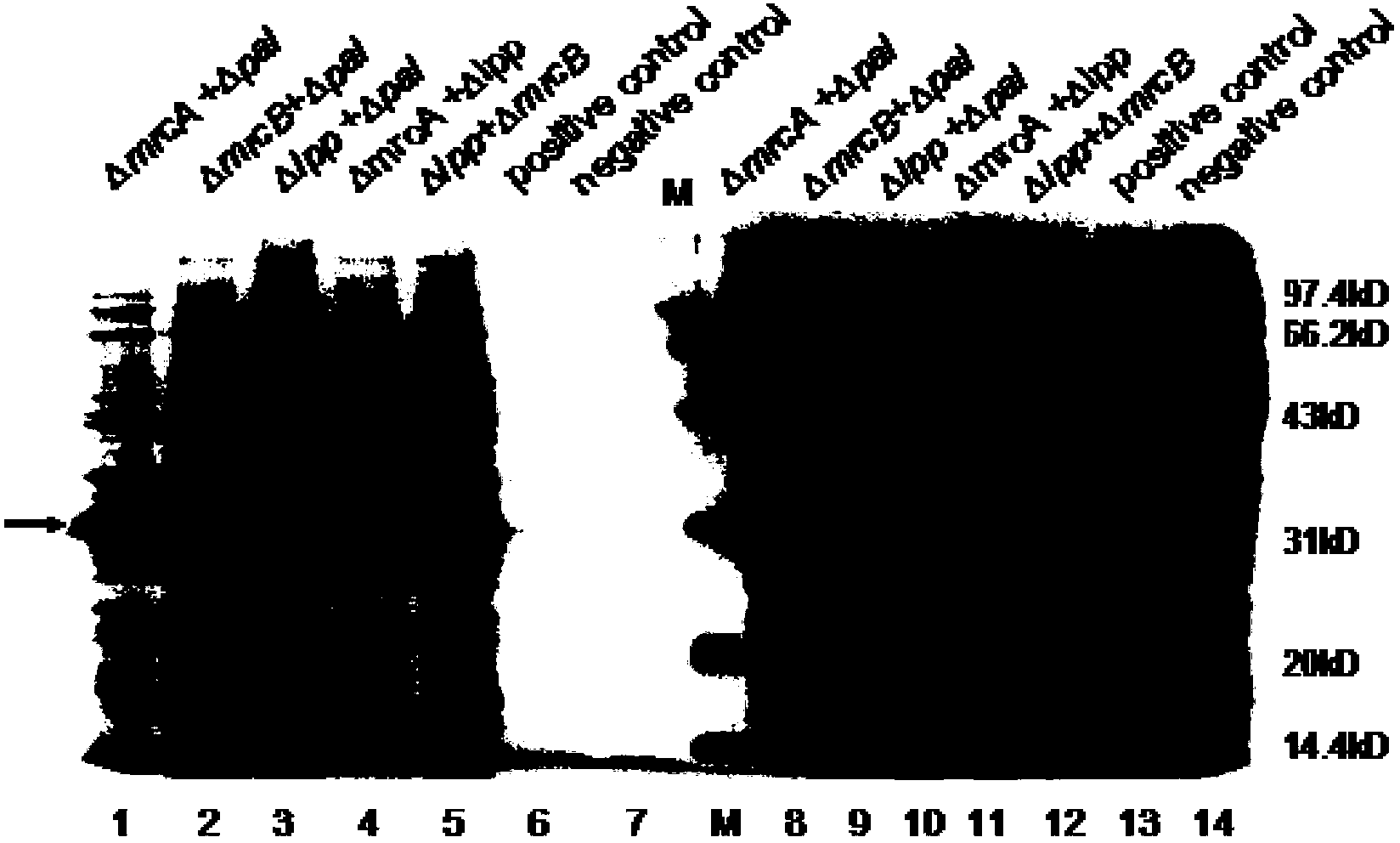Construction method for double-gene mutation escherichia coli used for secretory expression of recombinant protein
A technology for recombining Escherichia coli and Escherichia coli is applied in the field of genetic modification of Escherichia coli to achieve the effects of simplifying separation and purification, reducing production costs and reducing excessive accumulation in cells
- Summary
- Abstract
- Description
- Claims
- Application Information
AI Technical Summary
Problems solved by technology
Method used
Image
Examples
Embodiment 1
[0050] A method for constructing Escherichia coli for recombinant protein secretory expression, comprising the following steps:
[0051] A. pal and mrcB The construction of the double gene mutant secretory strain includes the following steps:
[0052] a. to build pal Mutated secretory strains:
[0053] (1) Use a pre-designed pal Gene knockout primers palH+PF and palH+PR, using the resistance marker gene plasmid pKD3 as a template, carry out polymerase chain reaction to synthesize specific PCR products, and obtain pal Gene targeting fragment, both ends of the targeting fragment are 50bp pal The gene homologous sequence, the middle is the chloramphenicol resistance marker sequence, and the obtained PCR product is used to obtain a purified high-concentration targeting fragment of 20ng / μl using a PCR product purification kit;
[0054] (2) Use 10 mmol / L L-arabinose to induce the E. coli starting strain JM109(DE3) containing the knockout helper plasmid pKD46 for 2 hours, a...
Embodiment 2
[0063] A method for constructing Escherichia coli for recombinant protein secretory expression, comprising the following steps:
[0064] A. mrcB and lpp The construction of the double gene mutant secretory strain includes the following steps:
[0065] a. to build lpp Mutated secretory strains:
[0066] (1) Use a pre-designed lpp Gene knockout primers lppH+PF and lppH+PR, using the resistance marker gene plasmid pKD3 as a template, carry out polymerase chain reaction to synthesize specific PCR products, and obtain lpp Gene targeting fragment, both ends of the targeting fragment are 50bp lpp The gene homologous sequence, the middle is the chloramphenicol resistance marker sequence, and the obtained PCR product is used to obtain a purified high-concentration targeting fragment of 20ng / μl using a PCR product purification kit;
[0067] (2) Use 10 mmol / L L-arabinose to induce the E. coli starting strain JM109(DE3) containing the knockout helper plasmid pKD46 for 2 hours, and ...
Embodiment 3
[0076] A method for constructing Escherichia coli for recombinant protein secretory expression, comprising the following steps:
[0077] A. pal and mrcB The construction of the double gene mutant secretory strain includes the following steps:
[0078] a. to build pal Mutated secretory strains:
[0079] (1) Use a pre-designed pal Gene knockout primers palH+PF and palH+PR, using the resistance marker gene plasmid pKD3 as a template, carry out polymerase chain reaction to synthesize specific PCR products, and obtain palGene targeting fragment, both ends of the targeting fragment are 50bp pal The gene homologous sequence, the middle is the chloramphenicol resistance marker sequence, and the obtained PCR product is used to obtain a purified high-concentration targeting fragment of 20ng / μl using a PCR product purification kit;
[0080] (2) Use 10 mmol / L L-arabinose to induce the E. coli starting strain JM109(DE3) containing the knockout helper plasmid pKD46 for 2 hours, ...
PUM
 Login to View More
Login to View More Abstract
Description
Claims
Application Information
 Login to View More
Login to View More - R&D
- Intellectual Property
- Life Sciences
- Materials
- Tech Scout
- Unparalleled Data Quality
- Higher Quality Content
- 60% Fewer Hallucinations
Browse by: Latest US Patents, China's latest patents, Technical Efficacy Thesaurus, Application Domain, Technology Topic, Popular Technical Reports.
© 2025 PatSnap. All rights reserved.Legal|Privacy policy|Modern Slavery Act Transparency Statement|Sitemap|About US| Contact US: help@patsnap.com

